Wind energy is the cheapest source of electricity generation
[Published 29 March, 2019]
Wind energy is today the cheapest source of electricity generation in majority of places in the world. Unsubsidized onshore wind energy is cheaper than any other energy source, including conventional power generation sources such as coal and gas.
According to the Bloomberg New Energy Finance data, the levelised cost of electricity (LCOE) of onshore wind in Europe ranges from $58 (€50) to $76 (€65)/MWh in H1 2018.
When taking into consideration pollution costs and subsidies, which are not included in LCOE estimations, onshore wind is by far the cheapest generation source in majority of places in Europe and the world. Offshore wind is on a steady cost reduction pathway with expected costs of €64/MWh by 2020 and €60/MWh by 2025 depending on projects pipeline.
Levelised Cost of Electricity (LCOE) of major power generation technologies in Europe

Source: BNEF
Auction results show how cheap wind energy really is
Most European countries have moved to award support mechanisms for renewable energy through auctions. In the last 6 years we have observed how cheap wind energy really is. Despite the differences in the duration and pricing mechanisms, onshore wind is consistently being awarded capacity between €34 and €70/MWh.
Average strike prices in auctions for onshore wind energy
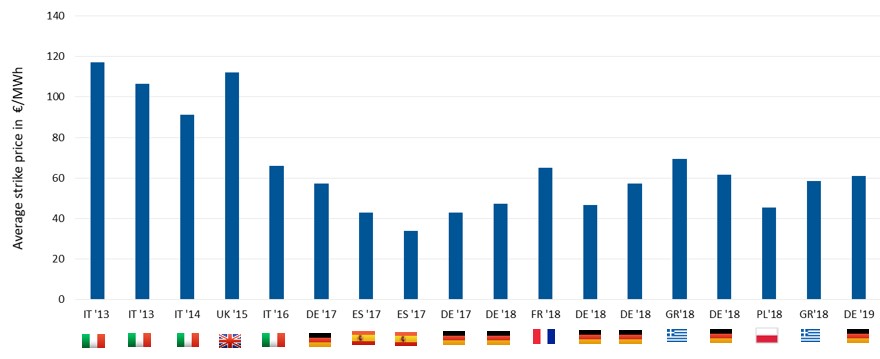
Source: WindEurope
Offshore wind is not far behind – auction strike prices suggest that costs have fallen 60% in three years. And the latest German and Dutch offshore auctions were awarded to build projects without public financial support. Nonetheless, these “zero-subsidy” bids are possible only for some developers in some markets, not least where governments take on and manage a share of the project risk.
Average strike prices in auctions for offshore wind energy*
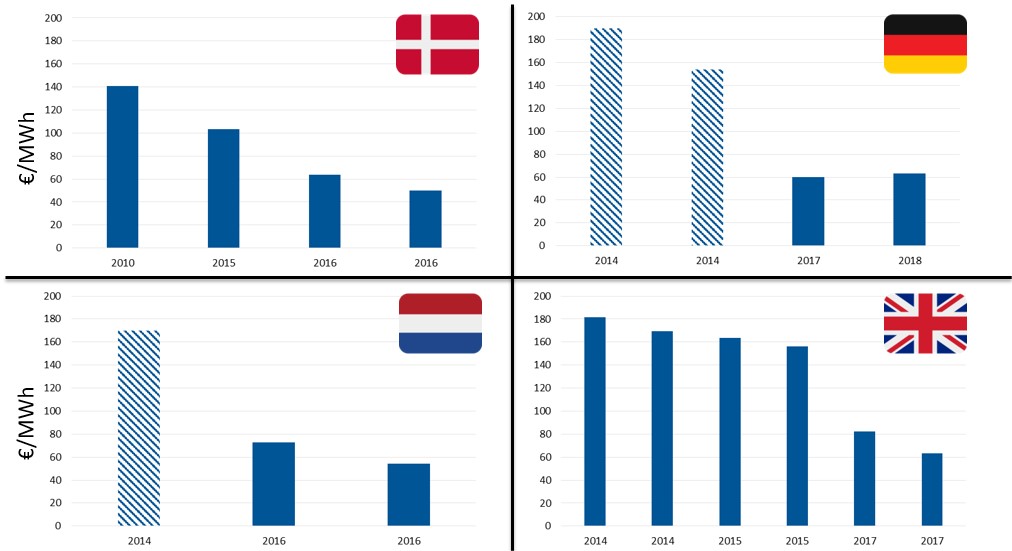
*2014 prices in the Netherlands and Germany are Feed-in-tariffs,
*2017 and 2018 values for Germany are weighted averages of non zero-subsidy bids in each auction round
Deploying wind energy via regularly scheduled auctions is critical to maintain a competitive industrial base.
Individual projects rely on the available regulatory framework at the time of the investment decision. But decisions to invest in factories, test facilities, logistics, skills development, research and innovation rely on multiple projects moving to construction over several successive years. Maintaining a calendar of regularly scheduled auctions can best provide the visibility to sustain cost reductions, and ensure fair competition.
Auctions will be a building block to reach the EU’s decarbonisation goals. Deployment scale, innovative technologies and upgraded energy infrastructure will be necessary if the EU is to achieve its goal of a fully decarbonized energy system by 2050. Managing successfully the transition period to 2030 will make or break the EU’s ability to fulfil its long-term energy system vision.
Basic cost of wind energy
Approximately 75% of the total cost of energy for a wind energy project is related to upfront costs such as the cost of the wind turbine, foundations, electrical equipment and grid connection.
Operation costs on the other hand are very small compared to fossil fuel technologies where as much as 40-70% of costs are related to fuel and operation and maintenance (O&M) for their entire lifetime.
The typical lifetime of an old wind farm is 20 years, although there are projects in the EU that have been operating for more time. Extending life of wind farms is an active area of research. Repowering existing projects with newer, scaled up technologies is also an important strategy in the long-term to improve cost competitiveness.
Age distribution of wind turbines, as of august 2018
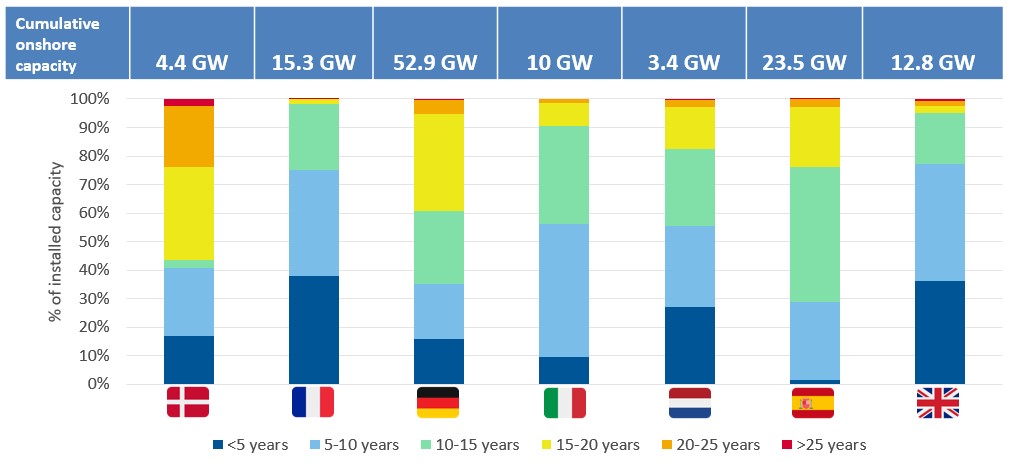
The state of the industry
Wind power is one of the fastest growing industrial segments in the world. Starting off as a niche market almost 30 years ago in Europe, wind energy today meets 14% of EU’s electricity demand with a cumulative capacity of 179 GW (189 GW in Europe) at the end of 2018.
In 2018, the wind energy industry installed 11.7 GW in Europe (10.1 GW in the EU) – more than gas and coal combined.
Wind is set to be the backbone of the future power system. It is poised to meet a quarter of Europe’s power demand by 2030. The IEA’s World Energy Outlook predicts it to be the leading source of electricity generation by 2027.
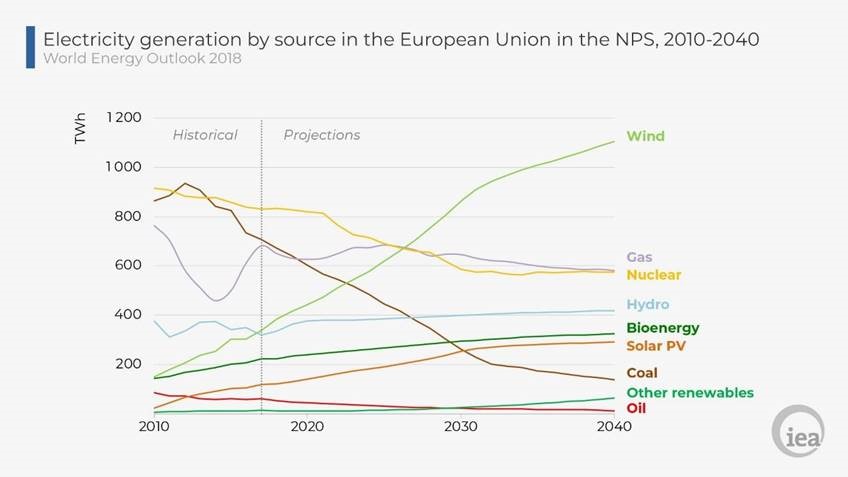
Source:International energy agency (2018)
Wind energy has created jobs, not only in turbine manufacturing and electricity production, but also in many other industries and economic sectors. In 2016 the wind energy industry accounted – both directly and indirectly – for 262,712 jobs in the EU.
The wind energy industry contributed €4.9bn in taxes to the EU economy in 2016. These include mostly corporate and income taxes, but also regional, local and property taxes. Taxes paid by the wind energy sector have grown by 46% between 2011 and 2016.
The wind energy industry contributed (directly and indirectly) €36.1bn to the EU’s Gross Domestic Product (GDP) in 2016. That is 0.26% of the overall EU GDP.
In 2016 the European wind energy industry exported €7.8bn and imported €5.4bn worth of products and services.
The impact of wind energy on jobs and the EU economy
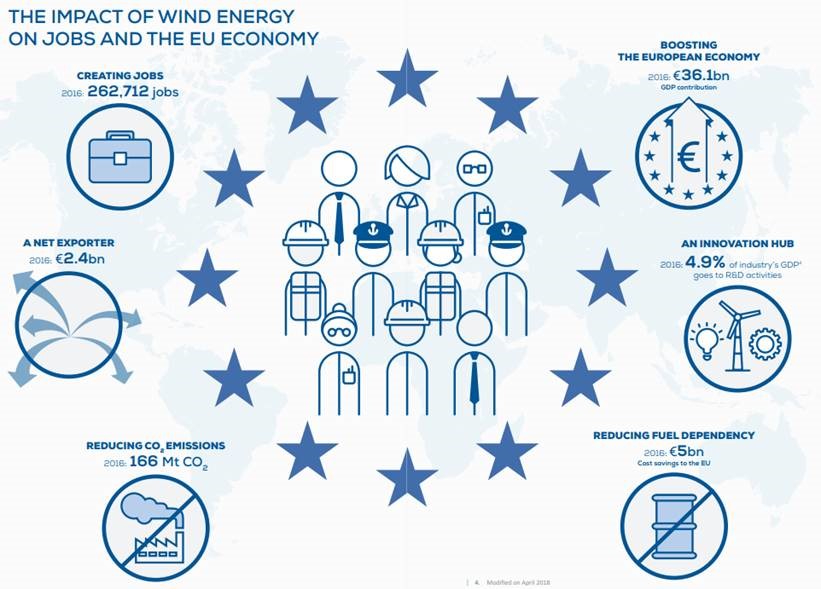
Source: Deloitte for WindEurope (2017)
The European wind energy industry’s vision to 2030 is to install 323 GW of wind energy capacity in the EU by 2030, 253 GW of onshore wind and 70 GW of offshore wind. That would be more than twice as in 2015 and a 55% increase from the expected capacity installed by 2020 (208 GW). Wind energy could produce 888 TWh of electricity, equal to 30% of the EU’s electricity demand.
The wind energy industry would invest €239bn by 2030 and provide employment to 569,000 people.
Macro economic benefits of wind energy under WindEurope’s 2030 scenarios
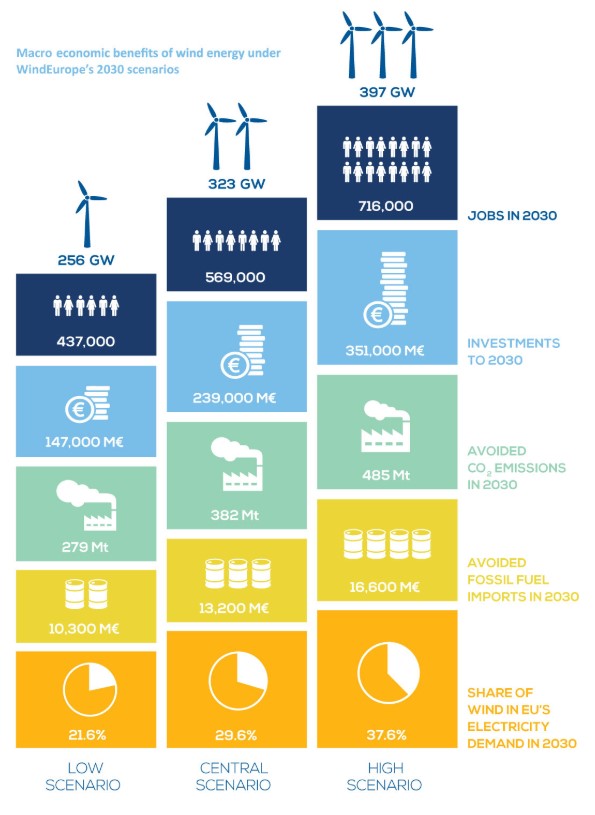
Source: WindEurope (2017)
Wind energy’s potential to 2030 and beyond will largely depend on more ambition from policy makers. To this end, a robust governance system should be agreed to ensure Member States collectively deliver on the 2030 binding renewable energy target and are rewarded for additional ambition.
Key texts and materials:


